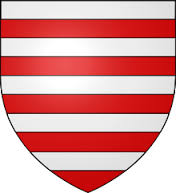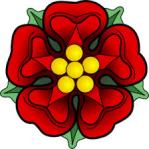A great device to give both historical and fantasy novels depth, are a Coat of Arms. A family history, or tradition, encompassed into a heraldic emblem, a brightly painted shield and banner, complete with family motto. This can give characters an intriguing edge, stories from their family’s past hinting at hidden secrets and mystery.
In a historical novel, especially those set in the High Middle Ages, they can be used to show authenticity, being such an important aspect of that age. Whilst in a fantasy novel, they are equally useful giving the authors world credibility and tantalising the reader into what the mythical land holds.
Heraldry in a Historical context
Some people date the start of heraldry as far back as ancient Egypt, when standards topped with the names of kings and gods, can be seen depicted in their art. However, the type of heraldry we would recognise as such today, started to appear in the middle ages when large armies, all being equipped with full helmets and faceplates, required some way for individuals to recognise one another. A crest on a helmet and a colourful design on a shield was a simple method of ensuing that they could tell friend from foe. The ‘coat of arms’ was developed further in the crusades, when knights found the use of a surcoat, worn over the armour, was beneficial to protect the knight from the hot sun and also could be used to display the knight’s family colours and affiliation. In fact, the three Lions of England, which is still used on the badge of the England’s football and cricket teams shirts, was first used by Richard ‘The Lionheart’ I in this conflict.

With so many different families, knights, and designs, spread throughout Christendom, it naturally became difficult to remember what devices belonged to who, so it became the responsibility of the ‘Herald’, a nobleman’s messenger, to remember them all and inform his lord, who was who. Hence the study of Heraldry was born, and the various rules and protocols associated with it.

Any historic novel set in the High Middle Ages must incorporate this branch of history, as it played such an important part in that time period.
Heraldry in fantasy novels
Like many aspects of our own history, heraldry is also found in many great fantasy novels. In Mark Lawrence’s Broken Empire series – where our world turns into a twisted shadow of our past – heraldry once again signifies the ruling families of the competing nation states. Whilst in Brandon Sanderson’s Stormlight Archive novels, we find the Knights Radiant. Ten orders of knights, each one following one of the Heralds – an elite group of semi-godlike beings who formed them. Each order wear armour etched with magical glyphs that represent their order and hold mystical properties, a neat adaption of the symbology so important to Heraldry.

However, it is in the Game of Thrones novels, by George R R Martin, that Heraldry really plays a huge part. The ruling families of Westeros all have family emblems and mottos that define their houses. The Lions of Lannister, the dire wolves of house Stark in the North, the Roses of Highgarden, all are known by their family traditions and house emblems. It is not surprising that heraldry plays such an important part in these novels, as so much of the story was inspired by the War of the Roses, the great conflict that divided England in the Middle Ages for generations.

Common devices used in Heraldry.
I couldn’t possibly list all the thousands of variations of heraldry and their meanings, however, if you want my (very) condensed and simplified versions of heraldry, here goes…
Firstly, you have the more simple shield designs, these tend to be in the form of the Cross, Saltire, cheques, stripes, or chevrons. These types of designs were called ordinaries.



However, the number of ordinaries’ variations were obviously limited, so powerful ruling families would commonly mount “charges” on their shields or banners. These could be man-made objects such as arrows, spears, or axes (as well as hammers, sickles, or horns) etc.


But more commonly were animals, such as lions, dragons, boars, unicorns, fish, Eagles, or any other thing that took their fancy.

These were displayed in typical poses, such as Passant: 
Vol: 
Rampant:
To distinguish various branches of the family, smaller symbols such as a crown, Rose, fleur-de-lis, or crescent could be added to distinguish seniority.

When various powerful families were joined together through marriage or other means (such as murdering their rightful heirs and stealing their castles and lands) they needed to combine two or more designs on the shield. This was called “Marshalling” and could either involve dividing the shield, quartering it, or dividing it up as many times as necessary so different branches of any given family could be represented.

And what of the Fleur de Lis?A widely used symbol appearing on a number of Royal families’ coats of arms as well as on crests of cities. In medieval France the lily embellished the tapestries of the Queens’ chambers and yet was branded into the living bodies of the women who sold the only asset left–themselves.
LikeLike